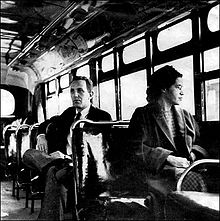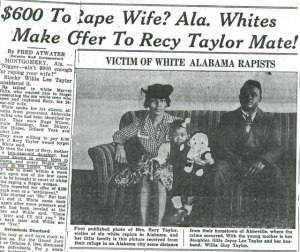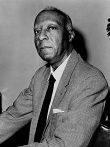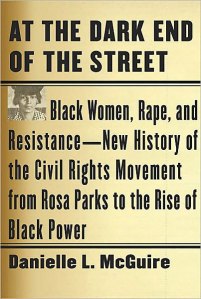Danielle L McGuire, At the dark end of the street : black women, rape, and resistance- a new history of the civil rights movement from Rosa Parks to the rise of black power (New York: Vintage Books, 2011).
At the Dark End of the Street reinterprets the civil rights movement by focusing on the sexual exploitation of women and showing that it has much earlier roots than the Montgomery Bus Boycott of 1955. McGuire shows that black women definitely had a prominent role in the Civil Rights movement but does not prove that sexual abuse of black women was the main cause of Jim Crow Segregation or the civil rights movement

A staged picture of Rosa Parks played into the myth that she was a little old lady that refused to give up her seat. It leaves out all of her valuable Civil Rights work before or after this one event.
McGuire does a great job of re-contextualizing the civil rights movement. She shows that the Montgomery bus boycott was not the start of the civil rights movement it came at the end of a long struggle of black women standing up for themselves against abuses on buses. The author does a good job to show that raping black women had roots going back as far as the slave trade and sprang up whenever blacks were gaining more rights like in Brown vs. Board of Education or trying to vote. It was also enlightening to put Rosa Parks into context that she had a grandfather who was a son of a slave and a white man and that she had been a long time anti rape advocate for a long time before she refused to give up her seat on the bus. This book also shows there were other women who refused to give up their seat like Colvin before Rosa Parks. This shows it was not the actual event itself but the publicity the Rosa Parks event gained that had a tremendous influence later on. This also raises an interesting point about teaching. I was never taught how much groups like the NAACP and other similar groups were involved in this event even though this fundamentally shapes how I interpret it. Can we do a better job at teaching these things in elementary school social studies or is that unrealistic because it is hard enough for students just to learn the basics? McGuire also shows how black networks were formed around protest of previous cases like Mary Pigford and Recy Taylor. So even though they were unsuccessful in these instances these networks helped blacks gain influence later on. Does a good job of showing how Rosa Parks was a very strong civil rights advocate but since she did not get to talk at the rally for the bus boycott that this transformed her image into a quiet unassuming woman. This raises the question of historical memory. Why did this interpretation of these events, one that understated the influence of women, become so popular when women were, in fact, vital to the movement?

Recy Taylor was gang raped by a group of white men, one of whom admitted to the crime. Even though all of the white men in her case were not charged the outcry in the black community helped create the organizational groups needed for future civil rights victories.
McGuire makes a convincing case that black women were involved in the Civil Rights Movement but does not prove that sexual abuse of woman was the only cause. She constantly shows how women were involved in the Civil Rights movement. For example, she showed how they were vital to the Montgomery Bus Boycott. She goes too far to quote Gunnard Myrdel stating, “Sex is the principle around which the whole structure of segregation…is organized.” Again she goes too fair when she states
The national campaign to defend Recy Taylor highlighted the power of sexual stories to mobilize communities and build coalitions. … This cut to the heart of people’s lives. It was deeper than voting rights, deeper than the poisons of stigma and exploitation, though those cruelties were also fundamental to the racial caste system…Taylor’s [a rape victim] refusal to remain silent helped expose a ritual of rape in existence since slavery, inspired a nationwide campaign to defend black womanhood, and gave hope to thousands suffering through similar abuses…sexual violence and interracial rape became the battleground upon which African Americans sought to destroy white supremacy and gain personal and political autonomy. That battleground is where the modern civil rights movement began, though its roots were as deep as the Atlantic slave trade.” (McGuire 47)
She does not take into consideration the book Worse Than Slavery that talked about how white people had an economic incentive to imprison black men to make them work for basically no pay. In some cases black women bus passengers were sexually abused but other times they were not. In addition, the black community chose to have a boycott of buses in response to Parks being arrested. This shows that there were economic factors involved and they were not just trying to protect black womanhood.
McGuire’s writing style is very engaging but at times lacks detail. She does a good job of talking about a lot of cases where black women were abused but also focusing in detail about a few important cases like Recy Taylor and Rosa Parks. This leads to a very dramatic book. For instance the opening pages about Taylor’s rape were intriguing. However, other times she just spends about two or three paragraphs on some of these racist incidents. There have been whole books written about some of these incidents like the Moore’s Ford Lynching and there is still mysterious to be solved. So it seems like McGuire might be missing some of the details in her brief summaries of these events. This affects her interpretation as well. For instance, she emphasizes George Dorsey defending Dorothy’s supposed sexual relations with a white man. However, Wexler emphasizes Roger Malcolm’s role and Dorsey’s sexual relations with two white women. This fits in with McGuire theme but these details are not mentioned, which makes one wonder what details or controversies she is leaving out of other events.
The best part of At the Dark End of the Street is that is shows that black people, especially black women, had agency in their struggle for equality against white Racism. This is something that missing in many other books about this time period. McGuire showed that blacks try to protect black womanhood just like whites tried to protect white womanhood. Neither black nor white felt that they could depend on government for protection under the law. Black women could not be protected by police or the courts when they were abused on buses so they formed their own boycott. Whites felt they needed to lynch black rapist because the government punishment was not

J. Philip Randlph was the leader of the Brotherhood of Sleeping Car Porters. He was instrumental in the civil rights movement including convincing FDR to enact one of the first executive orders to protect the civil rights of African Americans.
enough. This book shows that J. Phillip Randolph, a black labor union leader, was influential in FDR passing his civil rights executive orders. Whereas, Wexler talked about the same thing but did not mention that black people had a direct impact on this legislation. She also does an excellent job of showing black agency through blacks working through fraternities/sororities, black churches, and civil rights groups like the NAACP to respond to white racism.
This book also has many similarities to other books. The dark end of the street refers to the location of where most of these rapes took place but it also is a metaphor for white people wanting to keep these things in the shadows and not discuss them whereas black people wanted to publicize these abuses. This relates to many books such as the Fire in a Canebrake and the Stories of Scottsboro where whites in both cases just want to forget these abuses ever happened.
There are also fascinating connections between Parks and the trial of Scottsboro. Parks and her husband got involved in a movement to help free the black boys convicted in this trial. This helped get Parks more involved in the larger movement. McGuire also shows how the white people in the Recy Taylor rape case wanted to keep it low profile and not involve outsiders because they feared this trial would turn into the media circus that the Scottsboro case did.



